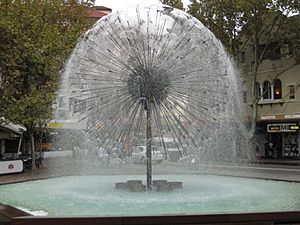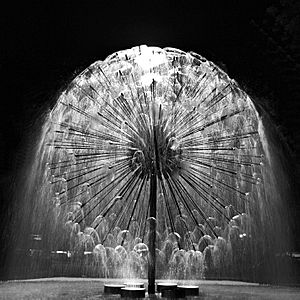El Alamein Fountain facts for kids
Quick facts for kids El Alamein Memorial Fountain |
|
|---|---|

El Alamein Memorial Fountain
|
|
| Location | Macleay Street, Kings Cross, City of Sydney, New South Wales, Australia |
| Built | 1959–1961 |
| Architect |
|
| Official name: El Alamein Memorial Fountain; Fitzroy Gardens Group; Kings Cross Fountain; King's Cross Fountain | |
| Type | State heritage (built) |
| Designated | 14 January 2011 |
| Reference no. | 1847 |
| Type | War Memorial |
| Category | Monuments and Memorials |
| Lua error in Module:Location_map at line 420: attempt to index field 'wikibase' (a nil value). | |
The El Alamein Memorial Fountain is a famous fountain and war memorial in Kings Cross, Sydney, Australia. It was designed by Australian architects Robert Woodward and Phill Taranto. The fountain was built between 1959 and 1961. It is also known as the El Alamein Fountain or Kings Cross Fountain. It was added to the New South Wales State Heritage Register in 2011. The fountain was created to remember soldiers who died in 1942 during World War II in two important battles at El Alamein, Egypt.
Contents
Why is the El Alamein Fountain a War Memorial?
The Australian 9th Division fought in two major battles at El Alamein in 1942 during World War II. These battles were very important. They stopped the advance of Axis forces into Egypt. They are seen as a turning point in the war in North Africa. The El Alamein Fountain in Sydney honors the Australian army's role in this campaign. It especially remembers the two El Alamein battles.
How the Fountain Design Was Chosen
In 1959, Woodward & Taranto won a competition to design the fountain. The Sydney Fountains Committee organized this competition. Their goal was to add beautiful fountains to public places in Sydney. They also wanted to remember important people and groups.
The committee wanted the fountain to cost no more than 10,000 Australian pounds. They also decided that the fountain would be a war memorial. It would be a place for people to gather on Anzac Day. This idea came from the Kings Cross RSL (Returned and Services League). They wanted a local spot for memorial services. Older servicemen found it hard to get to other memorials.
Who Designed the Fountain?
Robert (Bob) Woodward (1923-2010) and Phill Taranto were chosen to build the fountain in 1959. Woodward was 36 years old and had served in the Army. He studied architecture at Sydney University. The fountain was finished in 1961. The Lord Mayor of Sydney, Harry Jensen, officially opened it. This fountain became very famous. It led Woodward to design many other fountains around the world.
What Does the Fountain Look Like?
Woodward's design is Modernist. Many people say it looks like a blown thistle or dandelion. The fountain is made of bronze with brass pipes. It has many small nozzles that spray water finely. This makes the water look like a sphere. The fountain sits on a six-sided base. The water flows down three levels. It is also lit up at night, making it look beautiful.
How Did the Fountain Impact Sydney?
The fountain won an award in 1964 for its design. Over the years, its unique shape has made it a well-known landmark. Other builders have even copied its design. As a central point in Kings Cross, the fountain is often a meeting place for people.
What are the Fountain's Features?
This fountain has a globe-like shape. It is about 3.8 meters (12.5 feet) wide. It has 211 "stalks" that spray water. These stalks are attached to a hollow metal globe. This globe sits on top of a brass pipe that is about 3 meters (10 feet) tall.
The fountain has three pools made of concrete. They are covered with white mosaic glass tiles. Water is pumped up to the central globe. From there, it sprays out of each of the 211 nozzles. The water forms thin disks that merge together. This creates the look of a huge thistledown or dandelion. The water then falls from pool to pool. It then returns to tanks to be used again.
The fountain sits above the top pool. This pool is hexagonal (six-sided). The lower pools are larger but keep the same shape. Bronze "teeth" direct water down from pool to pool. This creates a soft noise that helps to block out traffic sounds.
Memorial Plaques at the Fountain
Near the fountain, there is a plinth (a block) with two plaques. These plaques explain the fountain's purpose.
One plaque says: 'THE EL ALAMEIN MEMORIAL FOUNTAIN THIS FOUNTAIN WAS ERECTED IN COMMEMORATION OF THE DEEDS OF THE NINTH DIVISION, AUSTRALIAN IMPERIAL FORCES IN WORLD WAR II BY THE COUNCIL OF THE CITY OF SYDNEY AND PLACED IN OPERATION BY THE RIGHT HONOURABLE THE LORD MAYOR OF SYDNEY ALDERMAN H.F. JENSEN ON 18.11.61 E.W. ADAMS TOWN CLERK'
The other plaque says: 'THIS FOUNTAIN WAS DESIGNED BY AND CONSTRUCTED UNDER THE SUPERVISION OF WOODWARD & TARANTO ARCHITECTS'
How the Fountain is Lit at Night
At night, the fountain lights up. It looks like fireworks bursting. Six powerful lamps are placed under the water in the top pool. These lights shine up through the water. This creates a beautiful display. The fountain's operation is controlled by a timer.
Why is the Fountain a Heritage Site?
The El Alamein Memorial Fountain is very important to the history and culture of New South Wales. It is considered a "State significance" site.
- A Unique Design: It is a spectacular fountain and a great example of modern design. Its unique water sculpture has been copied all over the world. In the 1960s and 1970s, it was a symbol of Sydney. It was as famous as the Sydney Harbour Bridge and the Sydney Opera House in tourist pictures. It was also a new way to use modern technology in fountain design.
- A Special War Memorial: It is important as a war memorial for the Australian soldiers of the 9th Division. These soldiers fought in the battles of El Alamein in Egypt. These battles helped change the course of World War II. The Australians suffered many casualties in these battles.
- Connected to its Designer: The fountain is also important because of its designer, Bob Woodward. He was a World War II veteran. The success of this fountain made him famous around the world for designing fountains.
- Rare and Unusual: It is rare because it remembers a battle, not just individual soldiers. It is also unusual because its beauty as a fountain is so striking. This beauty sometimes makes people forget its serious purpose as a war memorial.
- An Example of Excellence: The fountain is an example of excellent Australian modern design from the mid-20th century.
Fountains Like El Alamein Around the World
The El Alamein Memorial Fountain's design has inspired other fountains globally.
- A similar fountain can be found in Szczytna, Poland.
- The Gus S. Wortham Memorial Fountain in Houston, Texas, was inspired by it.
- Minneapolis, Minnesota has the Berger Fountain (1971), which is a copy.
- Tupperware Brands' headquarters in Kissimmee, Florida, has a replica (1970).
- Nuneaton, England, has a similar fountain called the Dandelion Fountain.
Images for kids
See also
 In Spanish: El Alamein Fountain para niños
In Spanish: El Alamein Fountain para niños



